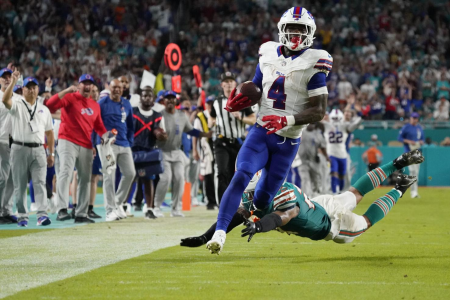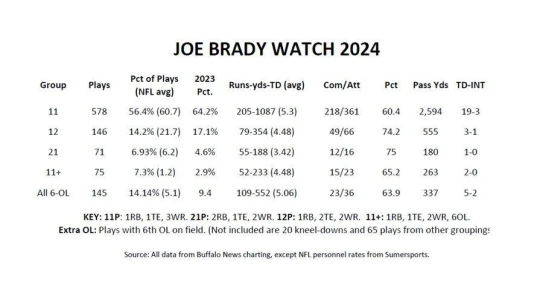
Bills offense review: Ability to impose will in run game made attack special
The Bills’ rushing efficiency was the best ever and second best in the league in 2024 to the Washington Commanders, according to NFL Next Gen Stats.
No matter how you slice it, the Buffalo Bills’ running game was more successful in the 2024 season than ever in the Sean McDermott era.
The Bills’ rushing efficiency was the best ever and second best in the league in 2024 to the Washington Commanders, according to NFL Next Gen Stats.
When the Bills spread out and ran with three wide receivers (11 personnel), the Bills were No. 1 in the league rushing efficiency, ahead of even the Philadelphia Eagles.

Bills running back James Cook rushes past diving Miami safety Jordan Poyer for a 49-yard touchdown during a game on Sept. 12. Harry Scull Jr., Buffalo News
When the Bills brought on sixth offensive lineman Alec Anderson – which they did 14% of their plays, more than any team in the league and way more than the league average of 5% – they were No. 1 in the NFL.
When they ran inside the tackles, their efficiency was third best in the league. When they ran outside the tackles, their efficiency was fourth best in the league.
“You need to be able to be a physical football team and be able to establish the line of scrimmage,” offensive coordinator Joe Brady said after the divisional-round victory over the Baltimore Ravens. “And I’m fortunate for the offense line that we have, the trust that I have in them and our backs understanding. You know, it always points to the offensive line. But the wide receivers and the tight ends that we have in the run game that are doing all the unselfish work. It’s critical.”
Particularly impressive was the Bills’ ability to impose their will on defenses via the run game. In 2023, the Bills averaged a pedestrian 3.45 yards a carry out of the big personnel. This year, it was a much bigger asset, with an average of 5.06 yards a carry, according to News charting. The combination of Anderson and right tackle Spencer Brown on the same side with powerful right guard O’Cyrus Torrence was formidable.
When the Bills went big personnel, the defense often stacked the “box,” putting eight men near the line of scrimmage. It’s the natural reaction. It didn’t matter. The Bills were No. 2 in the NFL in rushing success when they faced a “stacked box,” according to NFL Next Gen Stats. The box was stacked for the Bills the third-highest rate of run plays, 27.3%. Only San Francisco (29.1%) and Baltimore with Derrick Henry and Lamar Jackson (28.3%) faced more.
The Bills faced a light box (six or fewer defenders in the tackle-to-tackle area) only 25th most but still a good percentage of runs (37%). That coincides with their runs out of 11 personnel, when defenses were forced to respect quarterback Josh Allen’s passing ability. Not surprisingly, the Bills’ efficiency was second best in the league to the Eagles vs. light boxes.
“I think it’s very important to hit them on all different angles – hit them from the 8 hole all the way to the 9 hole,” said Bills offensive line coach Aaron Kromer late in the season, referring to the gaps on the wide sides of the formation. “If you don’t do that then they can start setting down into these blocks and there’s only certain things you do so they can set on those blocks a lot harder. It just makes it a little more difficult to gain yards.”

Kromer again took advantage of the athleticism of his tackles by pulling both Dion Dawkins and Brown. It wasn’t quite as much as in 2023 but still a lot and still very effective.
When Dawkins or Brown pulled on run plays in 2024, the Bills rushed 62 times for 312 yards, a 5.03-yard average, according to News charting. In 2023, it was 83 for 453 yards, a 5.46-yard average.
Explanation: The top “efficiency” metric is “expected points added,” which measures how well a team performs compared to expectations on a play-by-play basis. Expected points metric is based on down and yards to go until a first down, and distance to the end zone. Thus, a 10-yard gain on third-and-15 helps the yardage stats but is less valuable than a 10-yard gain on third-and-9 that keeps a drive alive.
Room for improvement
As has been well documented, the Bills’ “everybody eats” approach to the passing game could not have gone much better than the blueprint laid out by Brady and Co. before the season. The Bills finished No. 3 in the NFL in passing efficiency. They were ninth in total yards.The Bills were No. 6 in total yards after the catch, with slotman Khalil Shakir leading the way. He finished No. 2 in the league in yards after catch with 605, behind only Cincinnati’s Ja’Marr Chase (797).
Yet, the wide receiver room is an obvious area that needs improvement.
The Bills wide receivers combined for 190 catches, ranking only 21st in the NFL. The league average was 203.
And tight end Dalton Kincaid, who battled knee injuries and missed four games, had his catch total drop from 73 in 2023 to 44.
In the AFC championship game, when the Bills were in two-minute mode and didn’t have time to run the ball, the offense did not get the job done.
More motion
The Bills ranked fifth most in the league in the use of motion, at 73.5% of offensive plays, according to NFL Next Gen Stats. The league average was 61%. The Miami Dolphins led the league again at 82%, followed by the Los Angeles Rams at 80.7%. At the bottom end were the Denver Broncos (41%) and Jacksonville Jaguars (49%). The New York Jets and New England Patriots (54%) were on the lower end, too.The Bills’ rate of motion was up from 60.5% last year and 48.6% in 2021, Brian Daboll’s last year as coordinator.
The entire league is up over the past four years, as almost every team embraces the benefit of getting pre-snap indication of man vs. zone coverage and forcing the defense to communicate more.
Use of motion at the snap is way up, too. The Bills used motion at the snap on 26% of plays in 2024, according to Buffalo News charting, double the rate the previous year (13%).
Bills backup quarterback Mike White, who entered the league in 2018 and played for the Dolphins in 2023, talked about the motion development late in the season.
“Even when I got in the league, it was maybe one slow motion but they were still getting set and you’re getting a picture before they run the play,” White said. “Now it’s snapping on the run, on the move. It’s part of the game. It makes it harder on defenders, and they have to communicate more. Any time you can make them make checks on the fly, that’s when you make it hard on them.”
Motion at the snap on a run play causes the defense to make a last-second adjustment on its gap responsibilities. But it also can force the offensive line to make a last-second change in blocking responsibility if a defender is sprinting to the other side of the formation or a safety is hurrying down close to the line.
“I can argue it might be even more of a benefit of doing it running the ball,” White said for the offense. “Because if you’re in zone on a pass play and they do the motion, they (the defenders) kind of just slough off and let everything happen. But you’ve got to fill a gap at some point in the run game. If you hesitate enough, that gives the lineman who’s working up to the second level that much more of an angle on the block.”
Miami was way in front at motion at the snap at 64.7%. The Bills’ use of motion at the snap was 12th most in the league, and the Bills had the best success in the NFL when they used motion at the snap, according to NFLVerse data site. (The Bills’ offense was near the top of the league no matter how one broke down their tactics, but their motion at the snap was very effective.)
Strength of schedule
The schedule of defenses the Bills’ offense faced was not that tough – 23rd toughest in the league, according to FTN Fantasy Football’s value over average metric. Going into the season, it looked like it was going to be tougher. But the rest of the AFC East cratered in 2024. Miami, the Jets and New England all ranked in the bottom half of the league in defensive value over average.The Bills played five games against teams in the top 12 on defense – Baltimore, Detroit, Houston, Seattle and Kansas City. However, against great competition in the playoffs, the Bills’ offense rose to the challenge, scoring 31, 27 and 29 against three defenses that all ranked in the top 10 in fewest points allowed.
Personnel usage
Another area for improvement next season is in the usage of 12 personnel. Due to the injuries to Kincaid, the Bills went from 17% usage of one back, two tight ends to 14.2%. The league average was 21.7%.What’s noteworthy is the Bills passed very well out of 12 personnel. Allen completed 74.2% of his passes from two tight ends for 555 yards, a healthy 8.4 yards per attempt. Allen’s yards per attempt overall was 7.72, ninth best in the league. There’s opportunity there to exploit matchups more from 12 personnel, presuming Kincaid can stay healthy and revert to his rookie-season form.
The Bills used 11-plus personnel (one back, one tight end, two wideouts and six offensive linemen) on 7.3%. In reality, that group is like playing with 12 personnel because Anderson operates like a 305-pound tight end. The Bills passed well out of that grouping, too (9.36 yards per attempt), but just not as much. They passed 45% out of 12 personnel, 30% out of 11-plus personnel, obviously, because Anderson isn’t catching any passes.
